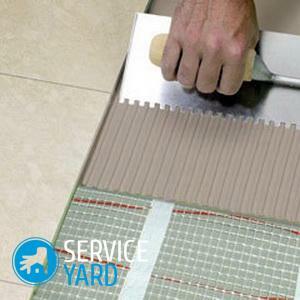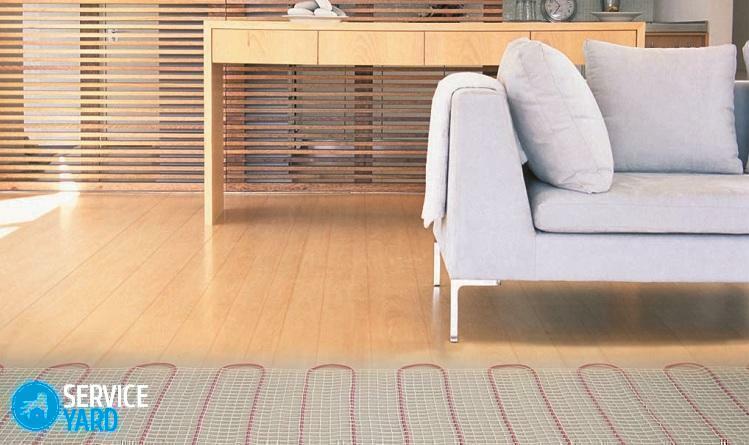
- Classification of
- How to make warm floor from heating in a private house: installation of a water floor
- Installation of an electrical floor
Agree, it is very pleasant to get up in the morning from bed and walk barefoot on the warm floor. Especially if the frost is falling or the snow is falling outside the window. Like? In the kitchen, too, I want to always be comfortable and comfortable, and if the floor is lined with linoleum or tiles, then you can not do without a carpet. After reading this article, you will learn how to make a warm floor in a private house. Despite the apparent complexity, all the work can be done independently.
to the contents ↑Classification of
If you have already decided on the technology of arranging insulated floors in the house, you can safely skip this section and proceed to the next. For the rest of the people, this information will be quite useful. There are two types of heated floors:
- Water.
- Electric.
Each of the varieties has its advantages and disadvantages. Let's dwell on each of the techniques in more detail.
The water floor
The name speaks for itself. Floor heating is done with water. Under the floor covering, lay a system of pipes through which hot water circulates.
Advantages of
Compared to electric underfloor heating systems, this system is more popular, and here are the reasons:
- Comfort. Water heating of the floors does not overdry the air, and the heat distribution is uniformly from the ceiling to the floor.
- Partial non-volatility. When the electricity supply is disconnected, the floor continues to be warm for another 1-2 days. The liquid cools down a long time and, despite the fact that the circulation of water is stopped, the system continues to work.
- Security. If the radiators have a risk of getting burns, then with warm floors it reduces to zero.
- Rational use of useful space. All heating elements are hidden under the floor covering. This means that the radiator can be thrown away( or, if you need it for something, put it in the closet).At the same time, of course, additional space is released.
- Possibility of combining with other types of heaters. This point will be especially liked by those who are afraid of cold weather.
As you can see, the list is quite extensive.

Cons
Along with the advantages, water-heated floors are not without some drawbacks:
- The water is cooling down quite slowly, and this is the advantage of the system. At the same time, it takes a fairly long time to heat the water. It takes at least a day to set the optimal temperature. Thus, to make a water-heated floor in a private holiday home, in which no one permanently lives, there is no sense.
- Impossibility of installation in apartment buildings, due to increased level of hydraulic resistance.
- Some complexity of installation, in comparison with the electric analog.
Important! If the integrity of the heating pipe is not observed, it is not possible to determine the fault location. So you have to disassemble the floor covering completely.
Electric underfloor heating
There are 3 types of electric underfloor heating:
- Heating cables. The system itself is not complicated, but it requires the arrangement of a screed over the cable.
- Electric floor mats. In essence, these are the same cables, but on a special grid. The cost of electric mats is higher, but there is no need to arrange screed.
- Heating film( infrared heater).It is installed together with a floor covering and requires less energy. However, the efficiency of heating large rooms is small.
Advantages:
- The system does not dry the air. The microclimate, created by electric heaters, is favorable even for people suffering from pulmonary diseases.
- The room is heated for a few minutes after turning on.
- You can easily change and maintain the air temperature. For this purpose the system is equipped with a special thermostat.
Important! The water floors are also equipped with thermostats, but it will take considerably longer to change the temperature.
Disadvantages of
Rather, there will be only one drawback, but it will seem to many to be very significant. This is the increased energy intensity of the project.
Important! The electricity consumption per square meter is 110-150 W.However, practice shows that using the regulators correctly, you can reduce the energy intensity to 70-100 W.
You can also hear the fables that electric mats emit some harmful fields. But this is a myth that has nothing to do with reality.
to the contents ↑How to make a warm floor from heating in a private house: installation of a water floor
So, did you choose a floor water heater? Consider how to make a warm floor in a private house with water heating. Before installing the pipe system for water circulation, a number of preparatory measures should be carried out:
- Level and clean the floor surface from the debris. After that, cover the surface with a waterproofing layer. It can be a strong polyethylene, with glued double-sided adhesive seams.
- Place the insulation layer on the polyethylene( foil - up).This improves the heat transfer of the system and increases its efficiency. To make laying more convenient, it is advisable to give preference to more rigid materials.
- Glue the damper tape around the perimeter of the room. Screed, drying up, will not be strongly compressed.
- Start spreading pipes, not forgetting to strictly follow the instructions. This is important, to avoid trouble later.
- Connect the system to the distributor. Before you fill the system with a screed, check it for holes in the pipes and other malfunctions.
- The final stage. Fill the floor with a concrete screed, level it well and leave it to dry.
Important! The order of work, how to make warm floors in a private house made of wood, differs little from the described. Instead of a screed in a wooden house, modular systems for fixing pipes are used. On top is a protective layer and floor covering.
to the table of contents ↑Installation of the electrical floor
The installation of the electrical system is carried out after the floor has been thoroughly leveled and cleaned of debris and dust:
- The floor is covered with a heat and waterproofing layer. For thermal insulation, it is advisable to use a foam with a thickness of 5-10 cm and a heat-reflecting foil layer.
- Next is the installation of heating elements. It is desirable to install heating elements where furniture will not stand.
- Then the reinforced screed is laid out and the floor covering is installed.
- The floor is filled with a cementitious screed.
- Sex must be sustained for a month. Only after this the system can be started to operate.
Important! If the film heating method is chosen, then you can do without screed.
You can arrange heated floors in several ways. Which method to choose is up to you. We hope that you managed to determine the optimal technology and perform everything qualitatively.



